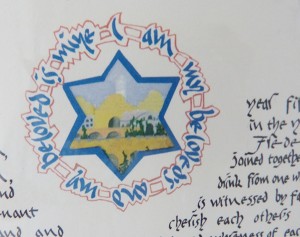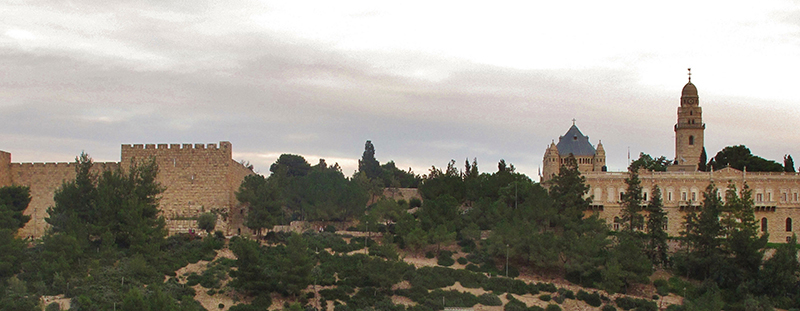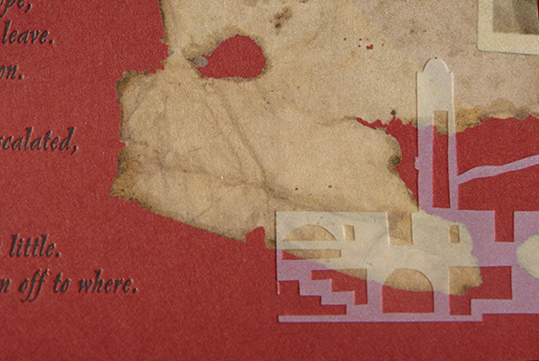When I had the idea of working with a papercut artist on The Amichai Windows, I never thought that I would end up working with the papercut artist who did the ketubah (Jewish marriage contract) when my wife and I got married years earlier.
But my wife, Laura, suggested that I look up the artist, Debra Band, and by chance we were now living a short drive away from each other in the Washington, D.C. area.
To give you a sense of Debra’s work, here are a few details of the ketubah that she did for us. It is a beautiful rendition of the Song of Songs. I have always loved the colors and the patterns made of intricate lettering, called micography, in which she writes in tiny letters.
Aside from ketubot, Debra also does Hebrew/English illuminated books of biblical and other Jewish texts, including The Song of Songs: the Honeybee in the Garden, I Will Wake the Dawn: Illuminated Psalms, Arise! Arise! Deborah, Ruth and Hannah, and her latest book, Kabbalat Shabbat: the Grand Unification.
Her work is found in private collections, institutions and galleries across the English-speaking world. Her artwork fuses Jewish spirituality, intricate calligraphy, illuminated paintings, gold leaf and fine parchment. Her extensive studies of Jewish texts and research into medieval European and Middle Eastern painting and manuscripts deeply inform her practice.
When I reached out to Debra, she enthusiastically accepted the challenge to make some papercuts that specifically reflected the poems in The Amichai Windows.
To give you an example of how we worked together, I asked her to make a papercut of the view of the Old City of Jerusalem from Amichai’s terrace. Here’s a picture of it which captures some of the Old City ramparts as well as the Dormition Abbey to the right. The abbey is a home for Benedictine monks; it is located on Mount Zion just inside the Old City walls.
In between the Jerusalem pines and scrub brush, which includes some large rosemary bushes, are paths that wind up the hill to a hidden entrance of the Old City.
After I showed Debra a copy of the photo, she did a papercut featuring the Dormition Abbey as well as David’s Tower, another imposing structure that is not visible in the photo.
It was not tenable to do actual papercuts for the edition. Instead, we decided to scan her original papercuts. What’s nice about this approach is that I could color her papercuts however I wanted — and I could use the negative space as an additional color, too.
In this example from Amichai’s poem, When I Returned, They Told Me There Is No, the first verse of the poem goes like this:
When I returned, they told me there is no
house and it’s nothing. And I have to
set off again for my wars
in which will be shed my private blood,
and I was one, now am many, soon again one.
The verse is about no houses left upon the return from a war. I wanted to integrate the architecture of present-day Jerusalem with the ancient history of the land and its battles. At the same time, I wanted it to reflect the view from Amichai’s terrace windows. Once Debra finished her papercut, I cropped it and made photopolymer plates. Then, I aligned the plates on a Vandercook proofing press and letterpressed the papercut images in opaque white ink over a photo of ruins of the scriptorium that was used in the Qumran settlement at the Dead Sea. The idea is to layer the architecture of present-day Jerusalem and the past.
The living quarters and rooms in which scribes copied Biblical texts have long since been destroyed, but they are echoed in my design — and thereby in Amichai’s poem, too.
While the ancient scribes were not poets per se, they were preserving poetic passages from the Bible; they worked not far from where Amichai used to live. In fact, the view from his terrace looks out towards the Dead Sea and the caves where the Dead Sea scrolls were found — and where the scribes lived at Qumran.
In addition, the spread for this poem includes a fragment from the Cairo Geniza as well as a photo of Amichai serving in the British army in the Western Desert of Egypt during WWII.
Here’s another image using Debra’s papercut in which she has captured David’s Tower, a structure that was also visible from Amichai’s terrace overlooking the Old City.
The tower is part of an ancient citadel located near the Jaffa Gate entrance to the Old City. Used as a museum today, it is built on the site of earlier fortifications that include Hasmonean, Herodian, Byzantine and the early Muslim periods. Important archaeological finds from here date back 2,000 years to the First Temple period.
Amichai used to love to walk throughout Jerusalem and the Old City in particular — and this is one of many places that he used to pass in his walks, a wanderer trying to capture a sense of home and history.






